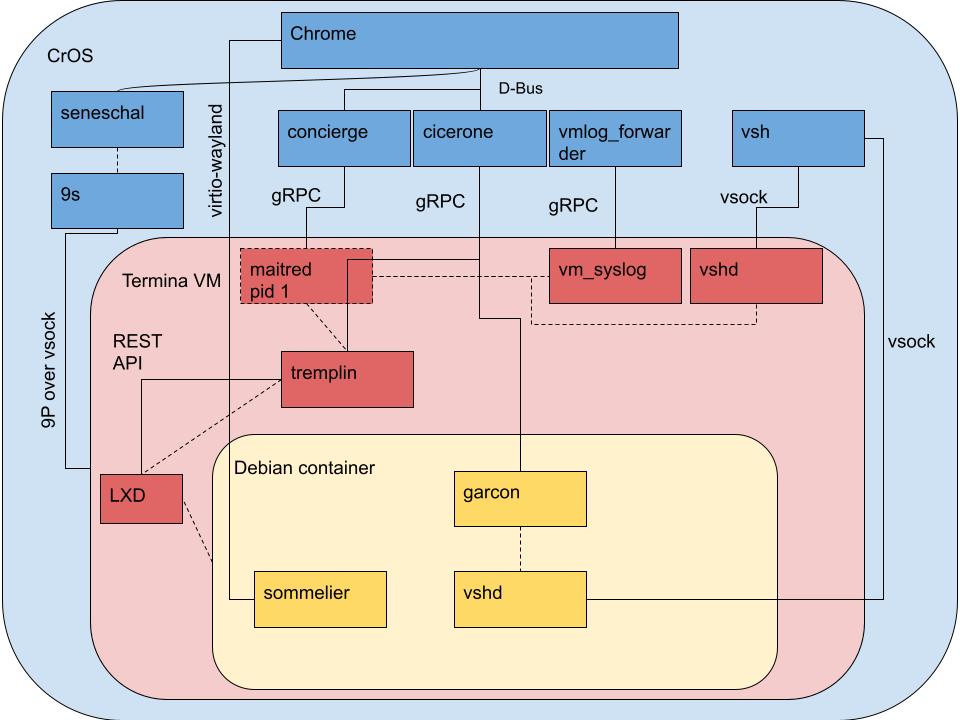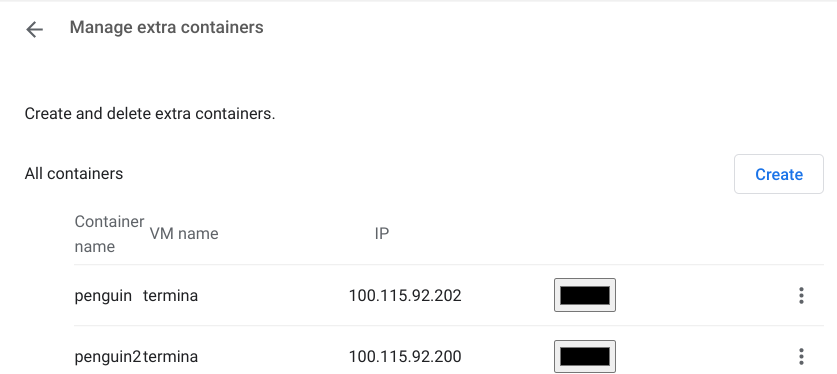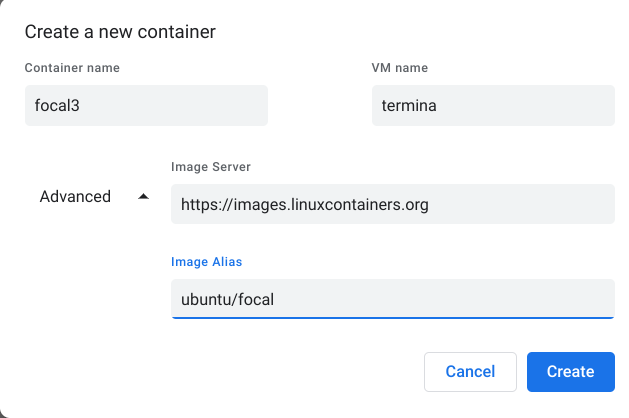Crostini is a system for running Linux in LXC containers on the Chrome OS operating system. LXC containers provide the user with a full operating environment, including a command-line shell; and optionally, a graphical user interface. Crostini was designed with a focus on insulating Chrome OS from security threats coming from inside the containers. This is great for developers who want a secure, managed, operating system; while also having access to a linux development environment.
LXC containers are similar to virtual machines, except that LXC containers are less demanding on resources (CPU, memory) because they share the system kernel amongst multiple containers. Whereas virtual machines virtualize an entire physical system, including the kernel. LXC containers differ from Docker containers, in that Docker is mainly used to virtualize single applications, like a web-server, rather than a whole interactive operating environment.
Crostini's architecture is complex. There are several layers of virtualization technologies nested within each other; as well as control channels that traverse layers. The Chrome OS setup instructions are sufficient for basic operation. However, understanding the architecture and terminology is helpful for making use of the more advanced features, and troubleshooting in the event something breaks.
Chromium OS is an Open Source Software project founded by Google. Software contributors, including Google employees in their professional capacities, contribute to Chromium OS. Google then pulls from the Chromium OS source tree to build their commercial Chrome OS products. The Chromium web browser operates on an identical model, being the underlying source code for Google's Chrome browser. For simplicity, we will refer to Chrome OS and Chrome browser.
Crostini runs well without any major configuration. If you just want to get started running Linux on your Chrome OS device, the instructions from Google are good. Chrome OS devices from 2019 onwards generally support Crostini. If your device is older, you can check if it is supported. If your Chrome OS device is controlled by an educational organization, Crostini may have been disabled.
Before following the Google install directions, one small improvement is to go into the Chrome browser and type chrome://flags#crostini-multi-container in the address bar, and enable this feature. As of Chrome version 98, on the Beta channel, this enables some additional options in the user interface to manage multiple linux instances.
This architecture diagram from the Crostini Developer Guide is helpful for understanding Crostini's various subsystems and how they interact. It should be read in tandem with Running Custom Containers Under Chrome OS, where the Overview sections gives a concise description of each of the subsystems. The following description is intended as a reference you can come back to, and may make more sense after getting some experience with running LXC linux containers.
On this chart, virtualization boundaries are represented with rounded corners (CrOS, Termina VM, Debian Container). Services and daemons are represented with square boxes. Communication channels are represented with solid lines. The dashed lines appear to represent a launch or initialization rather than a persistent communication channel. Note maitred pid 1 is the only service/daemon with a dashed outline. This appears to reflect its unique position as an "agent", which can be discussed later.
CrOS is Chrome OS, the host's operating system (light blue background). Termina VM (pink background) is a special, read-only, virtual machine instance that runs the LXD software that manages the LXC containers. Note it is the name of a virtual machine instance, rather than a service. In traditional terms it can be referred to as a "guest operating system." Debian Container (light yellow background) is an LXC container. The default LXC container is named Penguin. User-launched containers would be represented alongside Debian Container, as independent instances .
Two important pieces, not pictured, are crosh and crosvm. Crosh is a limited command-line shell that runs directly on Chrome OS. Crossvm is a "virtual machine monitor". In more traditional terms it can be thought of as a type-2 hypervisor. Crossvm is the execution environment for the special Termina virtual machine.
The nesting hierarchy of the various virtualization environments can be confusing. This tree shows the relationships.
Chrome OS (Host Operating System)
├── Chrome (Browser process)
├── Crosh (Command-line Shell)
└── CrosVM (Hypervisor)
└── Termina VM (Guest Virtual Machine instance)
└── LXD (Daemon)
├── Penguin LXC (Container)
└── LXC 2 (Optional user-specified container)
Garcon, Sommelier,and Vshd (yellow) are daemons that run inside LXC containers. They are installed with the cros-continer-guest-tools package. They cross the isolation boundary of the LXC container and the virtual machine. This enables users to use the Chrome OS user interface to control LXC containers.
This should be enough of an architecture understanding for intermediate-level running and troubleshooting of LXC containers. The following advanced section is included so that there is a complete explanation of the architecture diagram in one place.
There are a couple of flavors of communication channel: D-Bus, gRPC, REST API over unix socket, and Vsock. Most of the messages passing through these channels are protobuf format.
Seneschal uses the Plan 9 Filesystem Protocol to share a Chrome OS user's files (i.e. Downloads) with virtual machines (i.e. Termina), which are then mounted into a user's home directory in the LXC container.
Concierge is responsible for starting, stopping, and tracking virtual machines. It communicates to Chrome OS over d-bus.
Cicerone is responsible for communicating with containers. It talks to the [Garcon] service, installed by cros-guest-tools in LXC containers. It communicates to Chrome OS over d-bus
Vmlog_forwarder and vm_syslog work together to capture logs from virtual machines and store them in Chrome OS.
Tremplin Translates gRPC between Cicerone on the host and LXD in the VM.
Now that you understand the basic Crostini architecture, directly managing LXC containers will make more sense. The basic workflow is:
- Open Crosh, with the
Ctrl+Alt+Tshortcut. Or by navigating tochrome-untrusted://croshin Chrome. - At the
crosh>shell prompt typevmc launch termina - Your shell prompt should change to
(termina) chronos@localhost, and you are now logged into the virtual machine namedtermina. - From this
terminashell prompt you have access to thelxccommand, where you can create and manage LXC containers. - From the
croshshell prompt you can launch lxc containers that you have created viavmc termina <container name> - For best integration into Chrome OS, it is strongly recommended that you install the cros-continer-guest-tools
Crostini is under active development as of Feb 2022. There are ways to get the LXC containers into bad states. For example if you are starting and stopping containers via one interface (LXC or graphical interface), their state may not be picked up by the other interfaces.
Depending on your version of Chrome OS (Chrome OS ver. 98 beta channel confirmed working) you may be able to access the "Manage Extra Containers" option under Advanced > Linux Development Environment. To enable this feature:
- In Chrome type
chrome://flags#crostini-multi-containerand enable the feature. - Restart your Chrome OS device.
- If your device supports the multi-container feature, you will see an interface similar to:
At this point you have a pretty powerful setup. You can start/stop create/delete default LXC containers from this UI. From the desktop you can right-click (Alt-click) on the Terminal application, to choose which LXC container to connect to.
Crostini is under active development as of Feb 2022. There are ways to get the LXC containers into bad states. For example if you are starting and stopping containers via one interface (LXC or graphical interface), their state may not be picked up by the other interfaces.
There are several places where you can download pre-made LXC images, and run them directly. This requires placing a lot of trust in a third party that nothing malicious has slipped into those images. A user can also build their own LXC images using a variety of tools.
Historically the tool to use was lxc-templates, which is available in most distributions' package manager. Presently, the LXC project recommends using distrobuilder
The cros-continer-guest-tools enable communication between an LXC container and the Chrome OS operating system, traversing the virtual machine boundary. On a default installation, these tools are installed by attaching a virtual disk inside the LXC container and mounting it at /opt/google/cros-containers. lxd_setup.sh is run when the container is first created, which installs the cros-guest-tools. The guest tools are started in the lxc container via systemd unit files in /etc/systemd/users/.
For best integration into Chrome OS, it is strongly recommended that you install these tools.
- Add appropriate apt repo key - https://www.google.com/linuxrepositories/
- Add Google's repository to your system. Look at
/etc/apt/sources.list.d/crost.liston your default Penguin LXC, and create an identical file and contents on your new install. - Do
apt install cros-guest-tools
https://aur.archlinux.org/packages/cros-container-guest-tools-git/
Ubuntu is based on Debian, just like the default Penguin container. As such, the cros-guest-tools .deb installer mostly works. Sommelier doesn't install, so Wayland/GUI apps don't work, but you can get the integration with the default Terminal app working for a usable command-line experience.
You can use Advanced > Developers > Linux Development Enviornment > Manage extra containers > Create dialog to get started.
Verify that the container started, by opening Termina and executing lxc list, where you should see your container running. Execute lxc exec <container name> -- /bin/bash, which should give you a root prompt inside your container.
In that container:
apt update
apt upgrade -y
apt install -y wget gpg
wget -q -O - https://dl.google.com/linux/linux_signing_key.pub | apt-key add -
echo "deb https://storage.googleapis.com/cros-packages/98 bullseye main" > /etc/apt/sources.list.d/cros.list"
apt update
apt install -y cros-guest-tools
At some point this install will fail. Possibly on the cros-ui-config package. This appears related to the Chromium OS Sommelier package which provides the Wayland service for graphical apps.
Shutdown the container with shutdown -P now
In the termina virtual machine, you can verify the container is stopped with lxc list. Exit out of termina and in the crosh shell execute vmc container termina <container name>
On my system this immediately dropped me into a shell as user ubuntu on the lxc container. SystemD had started the garcon daemon, and right-clicking (alt-clicking) on the Terminal app allowed me to open a shell into the container. The container was also able to be stopped and deleted via the Manage Extra Containers dialog. The container was available across reboots, and just needed to be re-started via the Terminal app.
Further research can be done into de-coupling the gui and sound bits from the cros-guest-tools .deb meta-package, and only installing those guest extensions needed for a minimal Ubuntu install.
Possible workarounds to GUI issue:
https://github.com/quack1-1/scripts
https://github.com/pitastrudl/wekanwiki/blob/master/Chromebook.md#5-install-crostini-packages
https://github.com/LukeShortCloud/rootpages/blob/main/src/linux_distributions/chromium_os.rst
lxc list (defaults to containers)
lxc config show
lxc profile, lxc profile show
lxc remote list
If you launch an image that you don't have locally, it will first download it. To avoid this you can cp it locally first. be sure to --copy-aliases
lxc image copy <source remote>:<alias> <destination remote>: --copy-aliases
lxc image copy images:focal local: --copy-aliases
Adding a new remote:
lxc info --resources (information about running server) for more info, append --debug
Any number of profiles can be applied to a container. So you could have one that handles networking, another that handles mounts, etc.
Under Settings > Advanced > Linux Development Environment, you can forward ports to the LXC containers.
Todo: SSH access
By default a folder called Linux Files is created in Chrome OS, and this is mapped to the user's home directory in the LXC containers.
Additionally, you can select folders in the Chrome OS Files app, via right-click, to be shared into LXC containers.
Under Settings > Advanced > Linux Development Environment you can choose to pass USB devices through to the LXC containers.
For advanced troubleshooting, low-level development, or curiosity; one might wish to understand how Chrome OS works behind the scense. Especially considering that there appears to be some "magic" configuration of LXC containers.
It is possible to put a Chrome OS device into Developer Mode, by holding down ESC+Refresh while powering up the device. You will be prompted with warnings that continuing will wipe user data off the device. Once you complete the Chrome OS device setup, you can enter CRoSH shell (Ctrl+Alt+T) and then type shell to log into a non-virtualized, "bare-metal" shell on the device. You should see a prompt of chronos@localhost. The chronos user has sudo privileges.
Chrome OS uses Upstart as it's initialization (init) system. System configuration is stored in /etc/init/, and /sbin/initctl can be used to qquery the state of services. By default neither /sbin or /usr/sbin are in $PATH, although you will find useful executables there.
The command ps aux --forest is useful in seeing how the running system is organized. You can see user, process, and child-process information.
The control virtual machine, named Termina is loaded from /run/imageloader/termina-dlc/package/root/
Doing this from within Chrome OS is simple. In the Files app you right click a folder and select "Share with Linux." You can see shared folders in Settings > Advanced > Linux Development Environment > Manage Shared Folders.
The mechanism that accomplishes this is complex. The Chrome OS UI interacts with Seneschal over dbus and shares a narrowly scoped file system object with the virtual machine.
Seneschal is a daemon that runs in Chrome OS that handles lifecycle management of 9P servers. When Concierge starts a VM, it sends a message to Seneschal to also start a 9s instance for that VM. Then, while configuring the VM, Concierge sends a message to Maitred instructing it to connect to the 9s instance and mount it inside the VM.
This file system object is then somehow mapped into the LXC containers. It is unclear which of the several services maps the file system object from the virtual machine into the LXC container.
Presumably the commands to mount files into the container should be in protobufs definitions, but I cannot find anything. https://chromium.googlesource.com/chromiumos/platform2/+/HEAD/vm_tools/proto
Tremplin seems like a likely candidate, it has a communications channel to the Operating system via Cicerone And there are references elsewhere in the code about Tremplin doing file operations inside containers.
Maitrid is also a potential candidate for mapping file systems from the OS into containers.
This complexity is likely a result of the security philosophy underpinning Crostini. The security features around anything crossing security boundaries is strict. In this case there are strict processes around sharing files between host and containers.
Garcon receives a token from the host which is used to identify itself in all communication back to the host. This is bind-mounted into the container from the VM.
It is possible that the host mounts the filesystem into the VM, and also pushes the availability of the filesystem to Garcon, which then could mount it in the container. Alterantely, it is possible the host mounts the filesystem into the VM, and then via Tremplin, tells LXD to make the filesystem available into the container.
There is a sshfs running in Chrome OS fuse:sshf://@penguin.termina.linux.test. It is possible that ~/home is served as an SSHFS over vsock, where other shared files are served via 9s to /mnt/chromeos. The .test suffix may indicate this is just a way to test ssh keys by checking for a file however.
- If you are working off of tutorials, check that they are somewhat recent, Chrome OS/Crostini are developing rapidly.
- A list of useful Chrome OS URLS is available in your browser via
chrome://chrome-urls` - If Linux Developer Options do not appear or the multiple container UI doesn't appear, try restarting the system. Or try disabling and re-enabling the crostini-multi-container flag, or linux development environment.
chrome://chrome-urls
chrome://system#crostini
chrome://system#crosvm.log
This is a selection of useful links, it is not meant to be exhaustive.
https://www.chromium.org/chromium-os/
https://www.chromium.org/chromium-os/chromiumos-design-docs/
https://chromium.googlesource.com/chromiumos/docs/+/refs/heads/main
https://chromium.googlesource.com/chromiumos/docs/+/HEAD/costini_developer_guide.md
https://chromium.googlesource.com/chromiumos/docs/+/HEAD/containers_and_vms.md
https://chromium.googlesource.com/chromiumos/platform2/+/HEAD/vm_tools/docs/logging.md
https://chromium.googlesource.com/chromiumos/docs/+/HEAD/security/chromeos_security_whitepaper.md
https://chromium.googlesource.com/chromium/src/+/main/chrome/browser/ash/crostini
https://chromium.googlesource.com/chromiumos/docs/+/refs/heads/main/reporting_bugs.md#logs
https://chromium.googlesource.com/chromiumos/platform2/+/HEAD/vm_tools/vsh/
https://www.chromium.org/chromium-os/chromiumos-design-docs/boot-design/
https://chromium.googlesource.com/chromiumos/docs/+/HEAD/dbus_in_chrome.md
https://www.chromium.org/developers/mus-ash/ - discontinued 2019
https://chromium.googlesource.com/chromiumos/platform2/+/HEAD/crosh/src/base/vmc.rs
https://chromium.googlesource.com/chromiumos/platform2/+/HEAD/vm_tools/docs/init.md
https://chromium.googlesource.com/chromiumos/platform2/+/HEAD/vm_tools/init/vm_concierge.conf - nsenter details
https://blog.simos.info/a-closer-look-at-chrome-os-using-lxd-to-run-linux-gui-apps-project-crostini/
https://chromium.googlesource.com/chromiumos/containers/cros-container-guest-tools/+/refs/heads/main/lxd/lxd_setup.sh#35 -Confirms that Tremplin writes /etc/apt/sources.d/cros.list (Possible also writes systemd unit files then?)
https://github.com/edeloya/ChromeOS-Terminal-LXC-LXD
https://wiki.archlinux.org/title/Chrome_OS_devices/Crostini
https://medium.com/@tcij1013/lxc-lxd-cheetsheet-effb5389922d
https://wiki.debian.org/LXC
https://stgraber.org/2016/03/11/lxd-2-0-blog-post-series-012/
https://linuxcontainers.org/lxd/docs/master/authentication/
https://www.turnkeylinux.org/lxc
https://wiki.alpinelinux.org/wiki/LXC
https://wiki.archlinux.org/title/LXD#Create_a_container
https://wiki.debian.org/LXC
https://www.buzzwrd.me/index.php/2021/03/10/creating-lxc-containers-from-docker-and-oci-images/
https://blog.merzlabs.com/posts/crostini-now-usable/
https://blog.merzlabs.com/posts/yubikey-crostini/
https://source.chromium.org/
https://chromium.googlesource.com/chromiumos/platform2/
https://chromium.googlesource.com/chromiumos/platform/crosvm/
https://github.com/google/crosvm
https://chromium.googlesource.com/chromiumos/platform2/+/HEAD/crosh
https://chromium.googlesource.com/chromiumos/containers/cros-container-guest-tools/
https://chromium.googlesource.com/chromiumos/platform/tremplin/
https://chromium.googlesource.com/chromiumos/overlays/board-overlays/+/main/project-termina/
https://storage.googleapis.com/cros-containers
http://cloud-images.ubuntu.com/releases/
https://us.lxd.images.canonical.com/
https://us.lxd.images.canonical.com/meta/1.0/
https://us.lxd.images.canonical.com/meta/1.0/index-system.1
https://us.lxd.images.canonical.com/meta/1.0/index-user.1


